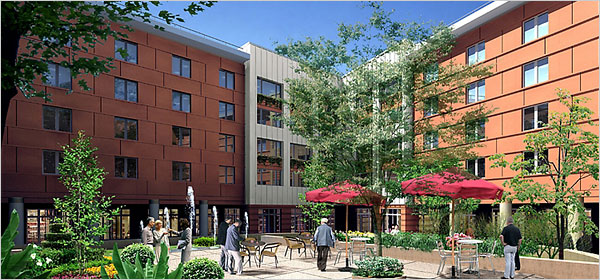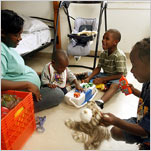IN what its developers are claiming is a first in the New York region, where land and construction costs are among the highest in the nation, the nonprofit United Hebrew Geriatric Center is building a $52 million nursing home with only single rooms, rather than double-occupancy ones — for federally insured patients, as well as those who are privately insured or wealthy.
The Geriatric Center, which offers a range of senior-living options on a 1.7-acre campus here, is attempting to alter the institutional, wardlike setting often associated with nursing homes that rely heavily on federal payments, where many frail and elderly people spend their last days.
To create a warmer environment, Perkins Eastman Architects, a large Manhattan architectural firm that specializes in senior-living projects, has also designed the geriatric center’s new building so that four of the five floors have clusters, or “neighborhoods,” in which a group of private rooms is built around central activity and dining areas. (One floor of the new building will include a 44-bed short-term rehabilitation unit, open to both the home’s residents and outsiders.)
L. Bradford Perkins, a senior partner at Perkins Eastman, said that in states like Maryland or Ohio, it costs about $150 per square foot to build a nursing home; that is about half the cost in Nassau and Westchester Counties and in the five boroughs of New York City.
Because the geriatric center is using land it already owns and has a strong base of financial support, it can afford to reduce its revenue by treating fewer patients than could be housed in a building of this size.
The new center, which will be called the Lucile and Joseph Skalet Pavilion, expects that its revenue from Medicare and Medicaid reimbursements and through payments from patients or their private insurers to cover most of the operating expenses..
A $6.7 million capital campaign is under way to help pay for the new construction of the 176-bed addition.
The private-room model of nursing care, though inherently more expensive, has become increasingly popular, because it helps elderly residents maintain their dignity and independence, Mr. Perkins said.
Perkins Eastman has designed all-private-room facilities in Ohio and a few other places, but there are still very few of them that accept Medicaid and Medicare.“For many years in New York State, the main option for frail elderly was a built-to-code nursing home, as prescribed by the state, where a person would live the last months of life in a hospital bed, sharing a room with another person with just a curtain in between,” he said. “Nursing homes had become an alternative that most people feared.”
That is changing, with architects getting contracts to build more patient-friendly nursing homes, and the state is encouraging senior care “a more homelike setting, whether that means in an institution or in a home itself,” said Robert Kenny, a spokesman for the New York State Department of Health.
State support for the “household model,” with a private room for each resident, grew out of conversations with consumer-advocacy group like AARP, Mr. Kenny said. “As more and more choices of heath care for seniors have become available, nursing homes have had to think of new ways to compete,” he said.
“Years ago, there were few alternatives,” he added. “Now they’re competing for a growing number of clients” with hospices, home aides, and other forms of care.
Rita C. Mabli, the executive vice president and chief executive of the geriatric center, said the neighborhood concept, as incorporated in the center’s new nursing home, and the broad range of services offered on its campus, are ahead of the norm in the industry, which is “preparing for the aging of the baby boomer population.”
About 18 percent of Westchester’s 940,000 residents are over 60. By the year 2020, the county’s 60-plus age group is expected to grow to 37 percent of the population, as baby boomers — those born in 1946 through 1964 — become seniors, according to the County Department of Planning and the United States Census Bureau.
The nonsectarian geriatric center, which, despite its name, now accepts patients of all faiths, dates to 1919, when a small group of elderly men resided in a small wood-framed building at the site. It is now a complex of buildings.
Willow Towers, an assisted-living residence with 126 market-rate rental units, opened in the past year. It is 90 percent occupied, Ms. Mabli said, explaining that “it typically takes several years to fill to capacity.” The current residents are 70 to 96 years old.
The center already has a 270-bed nursing home on the campus that was built in 1976, and serves residents aged 45 to 105. It will undergo some renovations as the new nursing home is being built alongside it and linked to it physically. The anticipated date for completion of the whole project is May 2008.
The campus also includes an independent-living apartment building with 135 federally subsidized units; most residents there are in their late 70’s. Maximum income levels for this building are $42,950 for one person and $49,100 for two people, according to guidelines set by the federal Department of Housing and Urban Development. Then, the rent is set at no more than 30 percent of the resident’s income.
The geriatric center, which also runs home health-care programs for 175 elderly people in Westchester and the Bronx, leases 5,000 square feet on its campus to a day-care center that serves 45 children.
“You see babies in strollers here as well as elderly people in wheelchairs,” Ms. Mabli said. “The idea of livable communities is being strongly promoted these days, as opposed to the idea of putting seniors away someplace on a shelf.”
The campus is set on Pelham Road, one of the main thoroughfares in the city, close to a large county park and near supermarkets and restaurants. Many residents still drive their own cars and are able to travel throughout the community.
Mr. Perkins, the architect, said that as the population ages, his company is experiencing increased demand for a variety of senior residential models. These include continuing-care communities, for which residents often pay an entry fee, as well as monthly charges, and have access to a spectrum of care that ranges from independent living to round-the-clock nursing and can change as the resident’s needs change.
Most recently in Westchester, Perkins Eastman designed Kendal on Hudson, a continuing-care retirement community that opened last year along the Hudson River.
Four years ago, it was the architect for Westchester Meadows in Greenburgh, the county’s first continuing-care complex. It was also the design firm for Classic Residence by Hyatt in Yonkers, a luxury rental senior-living community.








